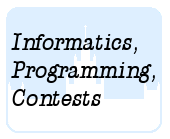Подразделы
Другие разделы
| Тренировка 1 |
| Тренировка 2 |
| Тренировка 3 |
| Тренировка 5 |
Дата и время
29/12/2025 22:37:22
 Тренировка 4
Тренировка 4
A. Geodes B. Bowling C. High Spies D. Digital Friends E. The Bavarian Beer Party F. Evacuation G. Decompression H. Rummikub I. Make it Manhattan
 D. Digital Friends
D. Digital Friends
 Олимпиадные задачи на английском языке
Олимпиадные задачи на английском языке
| 04/02/2008 | Зима 2008 дорешивание (4D) |
| 08/02/2008 | Тренировка (задачи Benelux APC 2006) (D) |
Ограничения: время – 2s/4s, память – 64MiB Ввод: input.txt или стандартный ввод Вывод: output.txt или стандартный вывод 
Послать решение Blockly Посылки Темы Где Обсудить (0)
Two positive integers are called friends if they consist of the same decimal digits. So 123 and 32331313323213 are friends, but 123 and 22121221 are not.
Two positive integers (that are not friends) are called almost friends if a single neighbour exchange in one of them results in a pair of friends. A neighbour exchanges two neighbouring digits `a` and `b` into `a-1` and `b+1`, or into `a+1` and `b-1`, provided that these new digits are still in the range `0…9`, and that no leading zero is generated. So 123 and 2223042 are almost friends (let `04\ →\ 13`), and 137 and 470 are neither friends nor almost friends (note that `13\ →\ 04` is not allowed).
The problem is to determine if two given integers are friends or almost friends.
Input
The first line of the input contains a single number: the number of test cases to follow. Each test case has the following format:
One line with two integer `x` and `y`, separated by a single space, with `0\ <\ x,\ y\ <\ 10^100`. Both integers start with a non-zero digit.
Output
For every test case in the input, the output should contain a single line with the string "friends" or "almost friends" or "nothing", reflecting the property of the two given integers
Sample Input
4 123 32331313323213 123 22121221 123 223042 137 470
Sample Output
friends almost friends almost friends nothing

 Начало
Начало